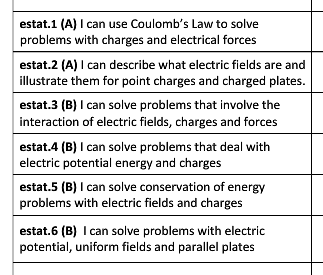The Big Idea of Electrostatics
I’ve often wondered if all of the segmented learning objectives in Standards Based Grading results in too much reductionism and micro-managing of learning, where the forest gets lost in all of the trees. In response to this, I’ve been reading “Understanding By Design” by Grant Wiggins and Jay McTighe, with hopes of clarifying the learning intentions with my students. Certainly my students should be aware of individual skills or required knowledge, but how these pieces fit into a bigger picture is more important.
As such, I’m crafting Enduring Understandings and Essential Questions for the Electrostatics unit. For this unit, I’ve luckily stumbled on to the actual suggested process of UbD. To begin with, I started with the required Prescribed Learning Outcomes, and transcribed them into specific established goals for the students, written in student-friendly objectives.
From this, I tried to come up with some Enduring Undertandings. I’m not an expert at this, but this is what I came up with:
“Electric Fields describe interactions that happen at a distance”
I think this Understanding is suitable because there is no one correct answer to it. It forces the thinker to challenge their idea of what a field is, what an interaction is, and to consider the many facets of the interaction.
From this Enduring Understanding, there unfolds a few Essential Questions:
- What is an electric field?
- What forces are present in an electric field?
- How do we describe these forces and interactions?
These essential questions are framed from a connotation of core ideas and inquiries, where the first two are topical questions and the last one is more overarching. Wiggins and McTighe say that it is important to have a mix of these two types in order to allow the students to explore the Essential Understanding in depth (overarching) while maintaining focus on specific yet perhaps ill-defined goals (topical).
By using this design process, I think I have already begun to give the unit a clear and unifying theme and way for the students to embrace the new ideas. We began with a discussion on charges and forces between charges, and now have done a constructivist inquiry activity on field lines and how forces vary within an electric field.
I still need to do some more work on this, as I don’t think I fully encapsulate all of the goals with the enduring understanding and essential questions. In particular, I think there should be some focus on potential and energy, otherwise it’s sort of left flapping in the wind. Potential and energy are neither forces nor necessarily interactions (in the same of something changing due to an interaction).

